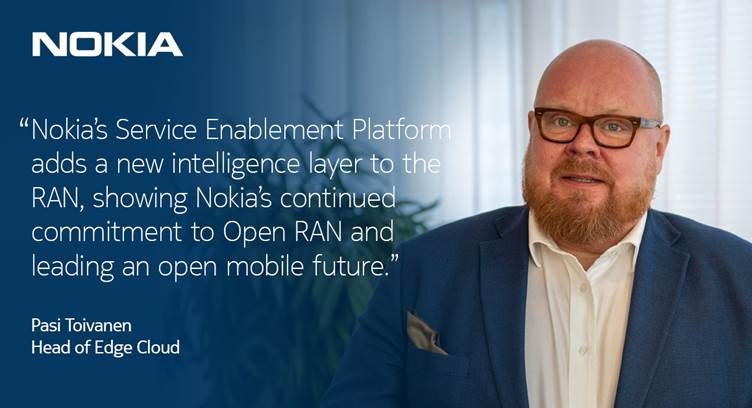Nokia last week announced the launch of its Service Enablement Platform (SEP), the first commercial solution to deliver radio network programmability, Artificial Intelligence (AI) and Machine Learning (ML) innovation across the Open RAN (O-RAN) ecosystem.
Nokia SEP launches with Nokia’s RIC xApps, including Advanced Traffic Steering and Anomaly Detection, which are currently in proofs-of-concepts and trials with major communication service providers (CSP).
Nokia SEP is the first platform to combine the near-real-time RAN Intelligent Controller (RIC) and Multi-access edge computing (MEC) together on a single platform, providing unique value and new innovative use cases. Nokia SEP leverages low-latency information to boost optimization through closed-loop automation and faster, more flexible service deployments. It also adds programmability with AI/ML technologies, enabling innovative RAN use cases, including Automated AI/ML-based network optimization xApps and enterprise-specific RAN adaptation. It is a single platform that deploys both RIC and MEC capabilities for intelligence and innovation, and it can be adapted for specific CSP or enterprise requirements.
Utilizing Nokia’s edge-optimized AirFrame servers, SEP can run on the edge and share infrastructure with Cloud RAN and other virtualized network functions. AirFrame Open Edge provides secured and high-performance ultra-small footprint edge cloud infrastructure for indoor and outdoor environments.
The platform launches with Nokia RIC xApps, a suite of plugins that give CSPs advanced control of 5G radio network use cases, including the Nokia Advanced Traffic Steering xApp, an AI/ML-based optimization algorithm that dynamically improves the efficiency of traffic distribution in the radio access network. It will also include the Nokia Anomaly Detection xApp, which uses machine learning to quickly detect and classify irregular behavior patterns in the RAN. SEP supports xApps from different providers.
Daryl Schoolar, practice leader for Service Provider Networks at Omdia
Nokia’s latest announcement about implementing the O-RAN standardized near real-time RAN Intelligent Controller (RIC) function together with MEC on its Service Enablement Platform product which supports xApps from multiple sources, including third-party, reinforces Nokia´s firm commitment to O-RAN and Open RAN solutions.
Pasi Toivanen, Head of Edge Cloud BU at Nokia
Nokia’s Service Enablement Platform adds a new intelligence layer to the RAN and enables the creation of high-value add use cases. This is part of Nokia’s continued commitment to leading an open mobile future with a strong network performance and security.






















